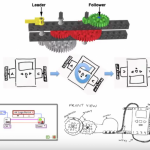Running a project-based robotics classroom often raises new and different issues than those found in more traditional classrooms. Here are some tips for classroom management.
Project Rules
Set clear expectations for students. A sample list of project rules is included below. Enforcing clear behavior guidelines improves the tone in the classroom considerably.
Sample Project Rules
We will be doing projects, both large and small, throughout the year. Sometimes your attempt will be a success. Other times, it will be a miserable failure. Either result is okay—failure is an integral part of the design process.
What is not okay: laughing at someone else’s project.
So, some rules for working in the class:
- You may not criticize or make fun of another student’s work. This includes laughing, teasing, or comparisons (“My car is so much better than your car….”).
- However, you may provide CONSTRUCTIVE criticism. To be constructive, the comment must be specific and offer a possible solution. For example, “Hey your car doesn’t go straight” is not acceptable, but “I noticed that your car veers to the left. It looks like the back wheel is rubbing against the frame” is welcomed.
- No designs are private property. Anyone may get ideas from any other design. If someone copies a piece of your design, the proper reaction is to be flattered—clearly, the other person has recognized your brilliance.
- If you get stuck, feel free to look at other people’s designs to see how they have solved similar problems.
- And finally, relax! Things will go wrong—but you will have plenty of time and assistance to fix the problems.
Encouraging Help
From the first day of class, encourage the students to collaborate and to help one another. You may want to have a rule that no designs are secret—the students are welcome to incorporate good ideas from other groups into their projects. Having another group adopt one’s idea can be seen as a real compliment.
If someone finds a clever solution to a problem, that person can be the “expert” on that issue and guide other students with similar problems. If students are having a good deal of difficulty with a project and seem stuck, suggest that they “go shopping,” walking around the class and looking at everyone else’s projects to see how others have tackled the problem.
Giving positive feedback to students who help one another shifts the class culture towards a norm of helping. The students no longer look to the teacher as the only source of advice; instead, they consult one another. Aside from making the atmosphere of the class more pleasant, doing this means that the teacher can supervise a whole class without being run ragged or having the students spend long periods of time waiting for help.
Competition
Competition is a fun and natural part of robotics. However, if a competition has a clear winner, it also has a room full of losers—not a cheerful prospect. Instead, consider having the students compete against a set standard; for example, can your robot stay inside the black lines for thirty seconds. That way, the potential is there for the entire class to win. Also, with this kind of competition, there is no penalty for aiding others or sharing a good idea—helping another group succeed does not diminish your own group’s prospects.
Failure
In a project-based class, failure is inevitable. An idea that seems good at first turns out to be a dead-end—or an outright disaster. As the upset students sit amid the ruins of their project, praise them for taking a risk and point out the positive aspects of their plan. Help them see what they have learned about which designs do and don’t work. Remind them that everyone in the class will have a design fail at some point in the year. Enforce the project rules to make sure that they get no jeering or other negative response from the other students.
Joyful learning
Finally, do not forget to have fun.
Barbara Bratzel
Latest posts by Barbara Bratzel (see all)
- New Cycles of Dr. E’s Challenges Are Here - 7 February 2019
- Snail Car - 23 August 2018
- Ramp Climber - 23 August 2018
- Does LEGO BOOST Have a Place in Education? - 20 January 2018
- EV3 books - 4 July 2017



This site looks great!
I love your section on classroom rules. I am a parent, not a teacher, but I am working on growing a community team where I will be holding meetings at my son’s school. Do you have more classroom rules other than the ones listed? My experience ‘teaching/coaching’ a group of kids is next to none. I would be ever so grateful if there are any other rules that you recommend…….or maybe some other examples of the positive encouragement. I do want to go over rules at our meetings AND be able to provide examples of positive feedback.
I have a goal of figuring out how to use a NXT robot with the EV3 software so that I can have more robots available for a growing team. We have one EV3 box, and I have one NXT, and know someone who has a couple NXT and I am hoping he can find those for the team.
Is there anyone who has any documentation or step by step